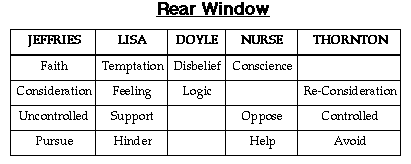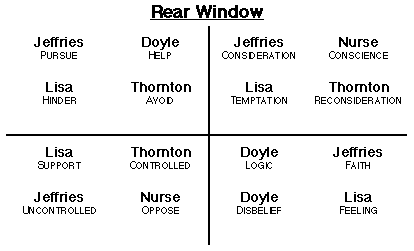The following is excerpted from an online class on story
structure presented by co-creator of the Dramatica theory of story, Melanie Anne
Phillips, signed on as
Dramatica:
Dramatica : Dramatica has four very important questions it asks about the Main Character. These questions are used by the software to arrange the relationships between character, plot, theme, and genre. Its kind of like a “Rubik’s” cube of story, as it were. These answers twist it into your unique arrangement.
Question one: Main Character Resolve. At the end of your story, has your Main Character changed or remained steadfast? Change or Steadfast is the question. Now some stories have a leap of faith where the M.C. must consciously choose to stick with their guns, or realize THEY might be the cause of the problems and CHANGE.
Scrooge is a change character. So is Luke Skywalker. Dr. Richard Kimble, or Job in the Bible are STEADFAST characters. Hollywood often has it that a character must CHANGE to grow. But Dramatica sees that a character can grow in their resolve as well. That’s why James Bond doesn’t seem to change but still works as a character. But there is always someone in the story who WILL change. In fact, if the Main Character changes, the Obstacle character will remain steadfast, If the Obstacle character changes, the M.C. will remain steadfast.
Who is Dr. Richard Kimble’s Obstacle? Who changes in The Fugitive? Any thoughts?
RDCvr : The policeman.
Dan Steele : Yes.
Dramatica : Right, Gerrard, the Tommy Lee Jones character. He starts out the first time he meets Kimble saying, “I don’t care!” And Kimble even brings it up to him in the police car at the end. And he says to Kimble, “Don’t tell anybody”, meaning that now he cares, he has changed. But Kimble didn’t! He never gave up… NEVER! In Goldfinger, if James Bond is steadfast,who changes? Who is the Obstacle Character?
Dan Steele : So one char. or the other HAS TO change their belief system by the end.
Dramatica : Yes, Dan, that is the nature of the author’s bias in the argument.
RDCvr : Goldfinger.
Dan Steele : Does Goldfinger dying count as a change in bel sys?
Dramatica : No, Goldfinger is an objective character – the Antagonist, in fact. Actually, Its Pussy Galore, the one who flies the plane – Honor Blackman.
Dan Steele : Oh, okay – yes
Dramatica : She changes from helping Goldfinger to helping Bond. Its not big, but it is there! It HAD to be there! Of course it is downplayed in an action story, and also the Obstacle character change is often underplayed because the M.C. is more important to the audience. But even Bond is asked at the end why she did it, and he replies, “I must have appealed to her maternal instincts”. It was important to make sure the audience knows that Bond was the one that changed her.
Dan Steele :So the antagonist provides the force against the main goal, but the obstacle char provides forces for belief system change?
Dramatica : Yes, Dan, exactly! That is the essence of the first question of Dramatica. Which kind of story do you want? The one where the M.C. sticks with their guns, or the story in which they are convinced to change? By making that choice, you not only know a lot more about your story and where it will go, but you have also had some impact on theme, plot, and genre as well. This doesn’t mean the M.C. will end up in a story filled with success. For example, by changing, they might give up just before they were about to win! So, outcome is a completely different thing. The question is not what they SHOULD do, but what they actually DO!
Dan Steele : So Resolve: change means MC sticks to guns, but Resolve:steadfast means either : 1) MC is convinced to change, or 2) MC changes another?
Dramatica : Right, Dan, that’s how it works.
Dramatica : Dramatica has four very important questions it asks about the Main Character. These questions are used by the software to arrange the relationships between character, plot, theme, and genre. Its kind of like a “Rubik’s” cube of story, as it were. These answers twist it into your unique arrangement.
Question one: Main Character Resolve. At the end of your story, has your Main Character changed or remained steadfast? Change or Steadfast is the question. Now some stories have a leap of faith where the M.C. must consciously choose to stick with their guns, or realize THEY might be the cause of the problems and CHANGE.
Scrooge is a change character. So is Luke Skywalker. Dr. Richard Kimble, or Job in the Bible are STEADFAST characters. Hollywood often has it that a character must CHANGE to grow. But Dramatica sees that a character can grow in their resolve as well. That’s why James Bond doesn’t seem to change but still works as a character. But there is always someone in the story who WILL change. In fact, if the Main Character changes, the Obstacle character will remain steadfast, If the Obstacle character changes, the M.C. will remain steadfast.
Who is Dr. Richard Kimble’s Obstacle? Who changes in The Fugitive? Any thoughts?
RDCvr : The policeman.
Dan Steele : Yes.
Dramatica : Right, Gerrard, the Tommy Lee Jones character. He starts out the first time he meets Kimble saying, “I don’t care!” And Kimble even brings it up to him in the police car at the end. And he says to Kimble, “Don’t tell anybody”, meaning that now he cares, he has changed. But Kimble didn’t! He never gave up… NEVER! In Goldfinger, if James Bond is steadfast,who changes? Who is the Obstacle Character?
Dan Steele : So one char. or the other HAS TO change their belief system by the end.
Dramatica : Yes, Dan, that is the nature of the author’s bias in the argument.
RDCvr : Goldfinger.
Dan Steele : Does Goldfinger dying count as a change in bel sys?
Dramatica : No, Goldfinger is an objective character – the Antagonist, in fact. Actually, Its Pussy Galore, the one who flies the plane – Honor Blackman.
Dan Steele : Oh, okay – yes
Dramatica : She changes from helping Goldfinger to helping Bond. Its not big, but it is there! It HAD to be there! Of course it is downplayed in an action story, and also the Obstacle character change is often underplayed because the M.C. is more important to the audience. But even Bond is asked at the end why she did it, and he replies, “I must have appealed to her maternal instincts”. It was important to make sure the audience knows that Bond was the one that changed her.
Dan Steele :So the antagonist provides the force against the main goal, but the obstacle char provides forces for belief system change?
Dramatica : Yes, Dan, exactly! That is the essence of the first question of Dramatica. Which kind of story do you want? The one where the M.C. sticks with their guns, or the story in which they are convinced to change? By making that choice, you not only know a lot more about your story and where it will go, but you have also had some impact on theme, plot, and genre as well. This doesn’t mean the M.C. will end up in a story filled with success. For example, by changing, they might give up just before they were about to win! So, outcome is a completely different thing. The question is not what they SHOULD do, but what they actually DO!
Dan Steele : So Resolve: change means MC sticks to guns, but Resolve:steadfast means either : 1) MC is convinced to change, or 2) MC changes another?
Dramatica : Right, Dan, that’s how it works.






